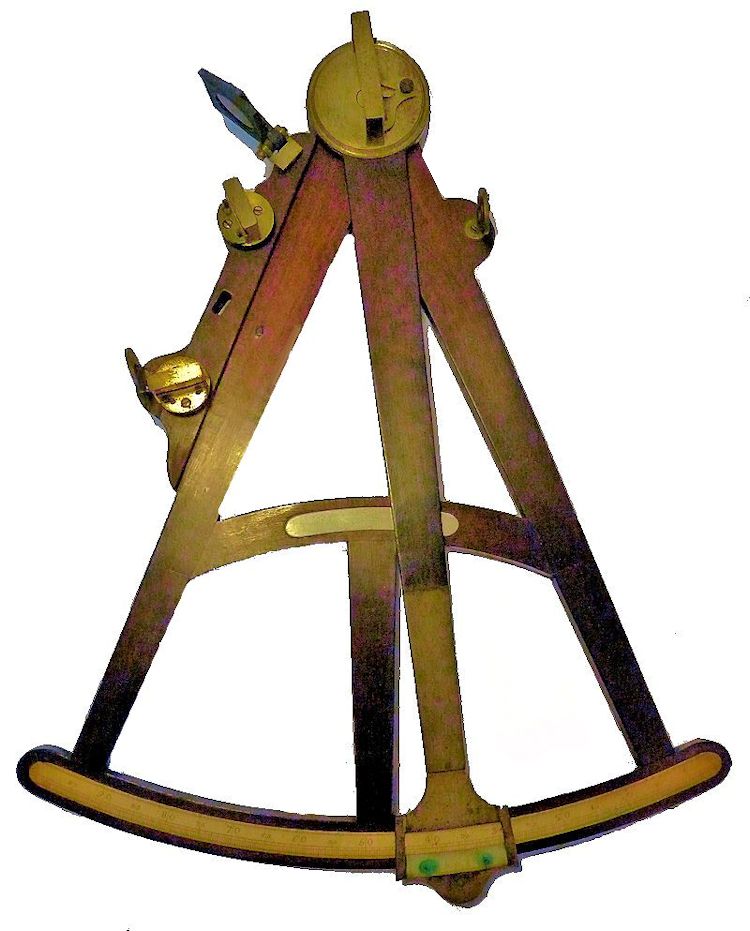
Presented is a very large octant with Mahogany frame and an index arm of 16 inches long that has an unnamed cross bar.
It is the same design, and only one inch smaller than Hadley’s “double reflecting principal” octant which was submitted to the Royal Society in London in 1731. Shortly thereafter, Hadley began selling octants with a vertical dimension of 17 inches compared to this instruments 16 inches. We can conclude that this example is one of the first to adopt
the Double Reflecting principal in its design. The carefully incised scribing of the numbers on the arc show they were
done by hand. The clamp that releases the index arm, predates the use of a tangent screw which was introduced in the 1820’s.
Mahogany was used before the change to ebony which also indicates its age. A unique feature of this instrument, which we have not seen before, is the raised platform upon which two horizon mirrors and the shades are mounted.
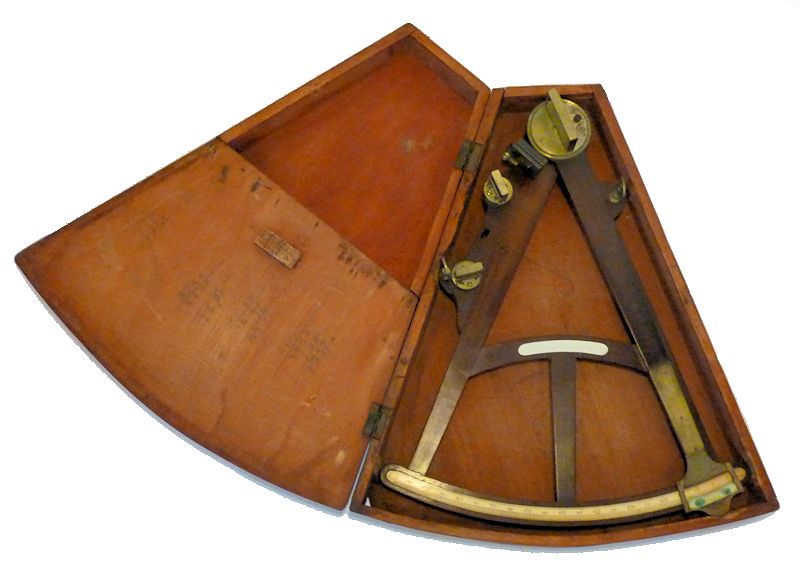 Hadley style octant Housed in a keystone, stair step case of the period It has the characteristics of a very early octant consisting of:
Hadley style octant Housed in a keystone, stair step case of the period It has the characteristics of a very early octant consisting of:
An early style Mahogany frame Three mirrorsTwo peep sights Cross member on frame Pencil holder receptical (missing) and ivory tab on backFlat wood index arm 16 inches or longer Graduated arc from – 5 degrees to + 100 degrees Vernier reading from right to left, 0 to 20 minutes Precisely machined bronze fittings shades (filters)
The three shade glass assembly is movable for placement at either the index mirror position or below at the secondary position where the third mirror allows for the taking of “back sights”.
The large size numerals on the arc and their minor variations indicate they were done by hand and not by an “Index Machine”. This suggests it was made by a superior instrument maker, standing at the top of his trade. In our opinion, it is the equal in quality of any instrument of this early period.
MARKINGS: The cross member has no maker’s name nor is there a maker’s mark on the ivory arc. Inside the case on the left top in large script is, “Daniel”. On the left inside top are various mathematical calculations which are seemingly meaningless. They do not represent the steps to figure Local Apparent Noon.
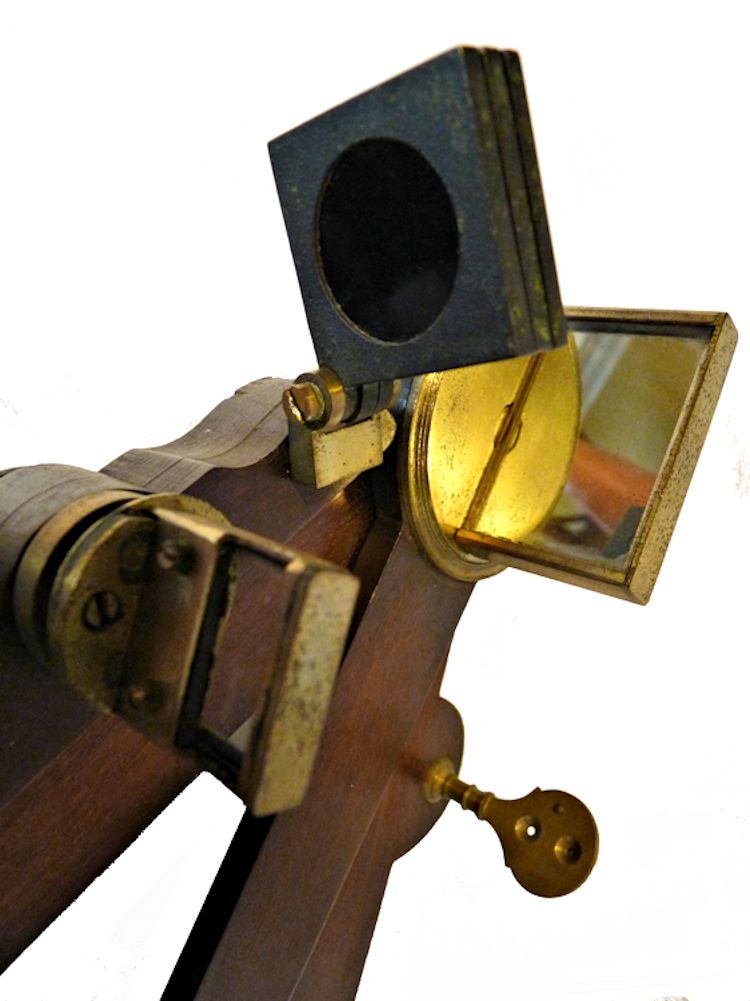
Index mirror, peep sight and three shade glasses
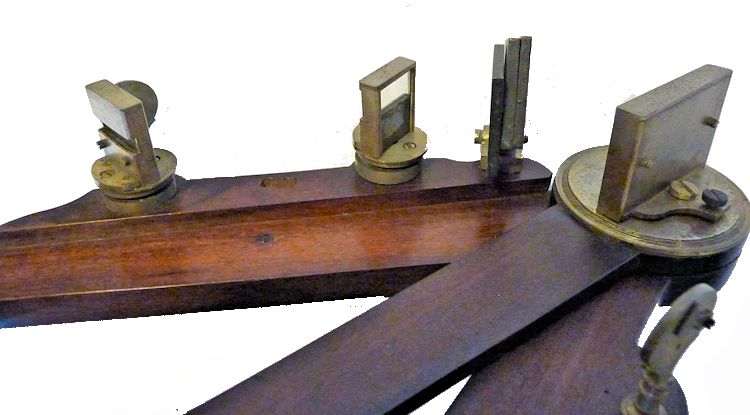 The unique platform upon which the shades and twin horizon mirrors are mounted
The unique platform upon which the shades and twin horizon mirrors are mounted
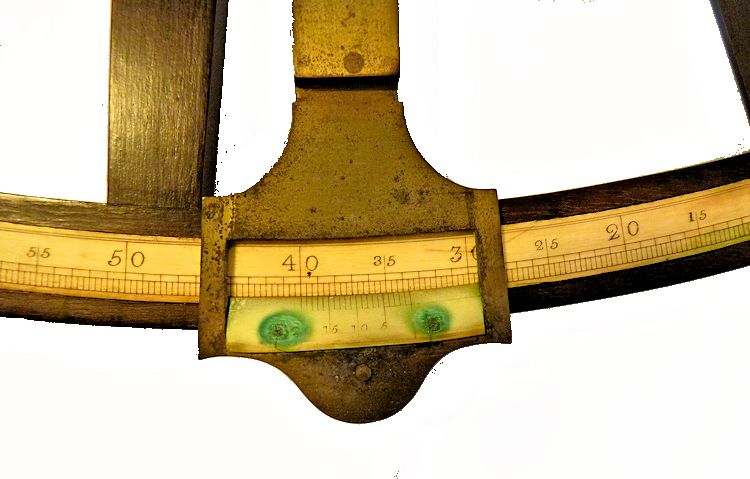 The octant’s vernier scale reading right to left in 0 to 20 arc minutes, Note the verdigris and the finger clamp
The octant’s vernier scale reading right to left in 0 to 20 arc minutes, Note the verdigris and the finger clamp
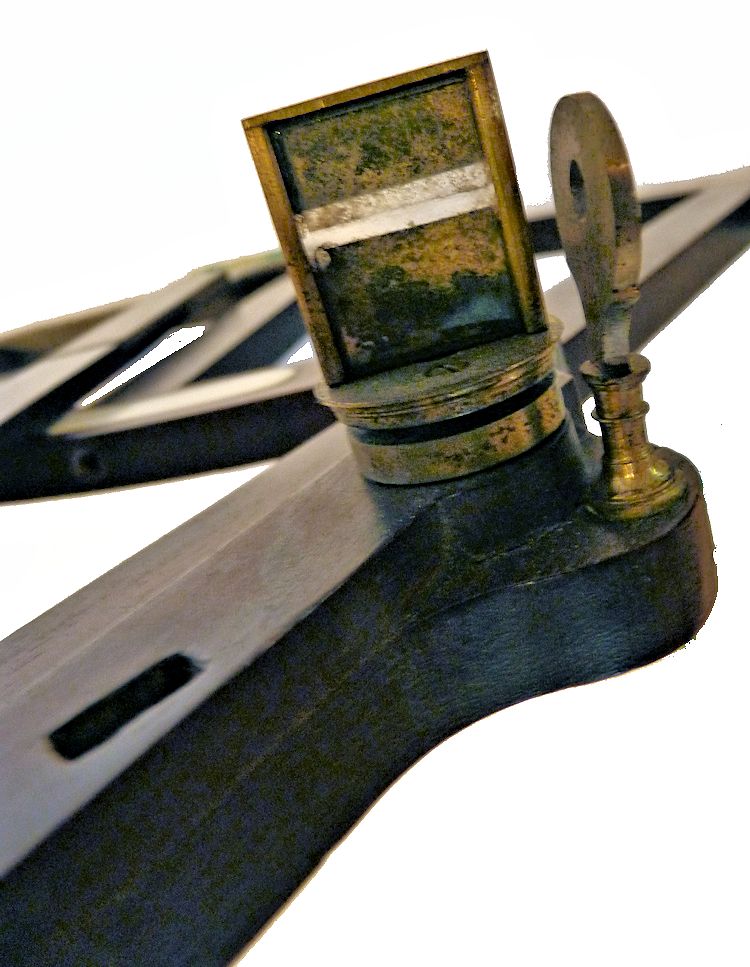 The degraded back sight mirrorThe fittings are precisely machined, which make this instrument a work of manufacturing excellence for this early a period.
The degraded back sight mirrorThe fittings are precisely machined, which make this instrument a work of manufacturing excellence for this early a period.
DIMENSIONS:
Arc reads – 5 to +95 degrees, Length of index arm 16″ long, Width of frame at arc 13 1/2″ wide, Index mirror 48 x 30 mm, Horizon mirror – 24 x 21 mm, Back sight mirror – 24 x 21 mm, Three movable shade glasses, Two Peep sights, Weight 2 Lbs 11 oz, octant and case each. Total 5 lbs
.DATING THE INSTRUMENT: The arc measures from minus 5 to 95 degrees on the scale. It is inlaid in the mahogany frame which is in excellent condition. It is known that mahogany went out of use in favor of Ebony some time after 1750. The octant has a flat mahogany index arm measuring 16 inches long with a finger clamp. Tangent screws began replacing finger clamps in the last quarter of the 18th Century.
The horizon mirror is mounted on an adjustable turntable. Its base can be rotated by loosening a screw which locks the mirror’s position. A third mirror is below it for taking back sights and is also adjustable. The ivory vernier scale reads from right to left from 20 to 0 arc minutes, a two hole peep sight, and movable three sun shades which serve both mirrors on the frame.
All of these features date the instrument to likely Ca 1774 -1775. Some time after 1780, the index arm clamp was superseded by an adjustable tangent screw, which also helps date this octant.
Peter Ifland’s comprehensive sextant work, “Taking the Stars”. particularly figure 64, page
 Closed keystone case with stair step image of the Period
Closed keystone case with stair step image of the Period
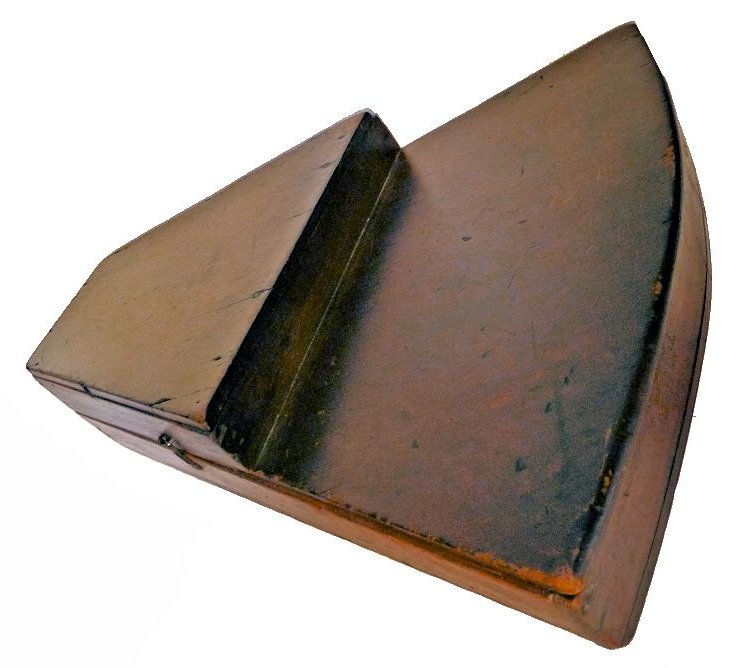
The back of the Hadley style octant. Two legs are missing
CONDITION: The instrument is in good condition except for some minor faults. On the back, some of the machinery has a deep patina of age and some doesn’t.The graduated arc is excellent, and all the hardware is present. Missing are all three bronze legs. It has a keystone ivory pad on back,but the original small ivory scribe is missing. The index and primary mirrors are in very good condition considering their age. The back sight mirror has lost most of its silvering. There are two spots of green verdigris on the vernier around the pins holding the scale.
The Case is the typical stair step, keystone design, of this period. It has been with the octant for a long time, but the carved out section at the lower right front may indicate it is not the original.
There is a missing piece of wood at the bottom of the left front and some scratches and wear marks, all around, but it is strong and sturdy. With the index arm set to the far right, the octant fits as it should. There is no lock, but there a period hook to hold it closed.
All in all, a rare, desirable, and special example of an early Hadley style octant by England’s early largest instrument maker
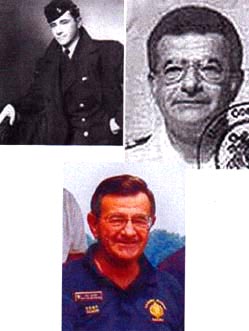 OUR QUALIFICATIONS: We are one of the few company’s still selling navigation instruments that know anything about them. For purposes of judging whether Joel’s opinion counts, he was the editor of the chapter on sextants of the 1977 Edition of “Bowditch”, The American Practical Navigator, NAVPUB 9; a member of the U.S. Naval Academy Navigation Syposium, 1975 -1978; the author of a book on marine sextants, Cornell Maritime Press,1975, and the founding president of Nautech Maritime Corporation which partnered with Tamaya in the introduction of the MS 733 Spica, the MS 833, Jupiter, MS 933 Venus sextants and the famous NC-2 navigation computer, in the U.S. market. Joel is also a retired Master Mariner, and held a U.S. Navy “D” Qualification as a Senior Skipper – Oceans. From 1995 through 2000, he served as a Varsity Offshore Sailing Team coach at the U.S.Naval Academy.
OUR QUALIFICATIONS: We are one of the few company’s still selling navigation instruments that know anything about them. For purposes of judging whether Joel’s opinion counts, he was the editor of the chapter on sextants of the 1977 Edition of “Bowditch”, The American Practical Navigator, NAVPUB 9; a member of the U.S. Naval Academy Navigation Syposium, 1975 -1978; the author of a book on marine sextants, Cornell Maritime Press,1975, and the founding president of Nautech Maritime Corporation which partnered with Tamaya in the introduction of the MS 733 Spica, the MS 833, Jupiter, MS 933 Venus sextants and the famous NC-2 navigation computer, in the U.S. market. Joel is also a retired Master Mariner, and held a U.S. Navy “D” Qualification as a Senior Skipper – Oceans. From 1995 through 2000, he served as a Varsity Offshore Sailing Team coach at the U.S.Naval Academy.
